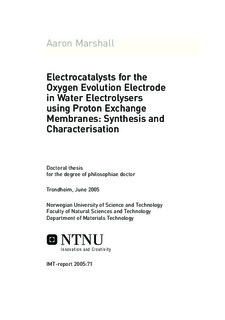| dc.description.abstract | Electrocatalysts based on IrO2 have been synthesised and characterised using a wide range of techniques. These oxide materials were primarily developed as oxygen evolution electrocatalysts for proton exchange membrane (PEM) water electrolysis. This development has enabled high performances to be achieved in a PEM water electrolysis cell. Overall the best result was obtained with an Ir0.6Ru0.4O2 anode and 20 wt% Pt/C cathode, with a cell voltage of 1.567 V at 1 A cm−2 and 80 °C when using Nafion 115 as the electrolyte membrane. This represents a cell efficiency of 76 % (εΔG) and an energy consumption of 3.75 kWhr Nm−3 H2 at 1 A cm−2.
Initial results showed that previous synthesis methods used for PEM water electrolysis electrocatalysts, were not suitable for multi element oxides, due to the formation of multiple oxide phases, and general controllability problems. This lead to the development of a new method, based on the thermal oxidation of metallic colloids. This method (modified polyol method) was then used to prepare IrxSn1−xO2 and IrxRu0.5−xSn0.5O2.
The effect of annealing temperature on IrxSn1−xO2 was examined and showed that the crystallinity increases, and the active area decreases, with increasing annealing temperature. The specific activity of this material however was seen to be constant over the entire temperature range, with the performance losses only due to the reduction of active surface area. At high temperatures, the solid solution of IrxSn1−xO2 was seen to become unstable, with segregation of SnO2 from the oxide lattice, and formation of metallic iridium.
The electrochemical properties of the oxides prepared at 500 °C, showed that the addition of SnO2 to IrO2 particles had no beneficial effect. Cyclic voltammetry showed that the active area decreases as the tin content increases, with this related to the crystallinity increase and dilution of the active iridium oxide sites. Additions of up to 20 mol% tin may be acceptable as little change in the active area occurs at low tin contents, however there was still a 40 mV increase in cell voltage at 1 A cm−2 and 80 °C in a PEM water electrolyser. The specific activity of the oxides prepared by the polyol method remains constant until 50–60 mol% tin whereafter the activity decreases. Overall, the electrocatalytic properties in 0.5 M H2SO4 and a PEM cell are similar, however there is evidence to suggest that there are extra resistance issues in the PEM cell due to the poor conductivity of some of the prepared oxides. The effect of anode composition on the PEM cell ohmic resistance confirmed that high tin contents causes high performance losses due to poor layer conductivity.
IrxRu0.5−xSn0.5O2 electrocatalysts showed that additions of 15–25 mol% ruthenium improved the overall oxygen evolution performance at low current densities. However due to agglomeration of metallic ruthenium during the colloid synthesis stage, the electrochemically active area of this oxide, decreased with ruthenium content. XPS revealed that the reduction in active area was directly related to the concentration of noble metals at the surface of the powders. The specific activity of the iridium species at the electrode surface was seen to increase as the ruthenium content of the bulk increased. This finding maybe due to a “support” affect, in which the underlying ruthenium influences the structure and electronic properties of the surface iridium. This reduced active surface area and the increase specific electrocatalytic activity resulted in an optimum in the electrocatalytic performance towards the oxygen evolution reaction at 15–25 mol% Ru.
IrxRuyTazO2 nanocrystalline and amorphous powders were prepared by a hydrolysis method. These oxides exhibited high active surface areas and supercapacitor like properties with the electrode capacitance typically around 200-300 F g−1. No evidence was found to suggest that tantalum oxide forms solid solutions with iridium or ruthenium oxides. It was found however, that the lattice parameters of the rutile oxide in IrxRuyTazO2 samples, can be explained by a solid solution between IrO2 and RuO2. Electrochemical measurements showed that additions of tantalum decreased the electrochemically active surface area, as did high levels of ruthenium. At intermediate ruthenium contents, it was shown that both the low current and high current performance in a PEM water electrolysis cell was very high. Additions of up to 20 mol% Ta are possible without significantly decreasing the performance.
X-ray absorption spectroscopy was used to examine a range of oxide electrocatalysts using both ex-situ and in-situ measurements. The in-situ measurements were performed on oxide electrodes polarised in aqueous 0.5 M H2SO4 electrolyte. The ex-situ measurements on IrxSn1−xO2 showed that it is unlikely that Ir and Sn are atomically mixed as there was no evidence to suggest that Sn is within the first few coordination shells of the Ir. In contrast, for IrxRu1−xO2, Ru was found in the first few Ir–metal coordination shells. Electrochemical measurements showed that for amorphous IrO2, increasing the electrode potential from 0.5 to 1.4 V causes there to be more d-orbital vacancies in the iridium atoms. A valence change (probably Ir3+ → Ir4+) also occurred between 0.9 and 1.0 V vs RHE and there was no evidence to suggest that the iridium was present in any higher oxidation state. From the EXAFS analysis, it was found that the Ir–O bond length decreased by 0.05°A as the potential increased from 0.5 to 1.4 V vs RHE. This is in good agreement with the expected bond length change due to valence change. | nb_NO |
